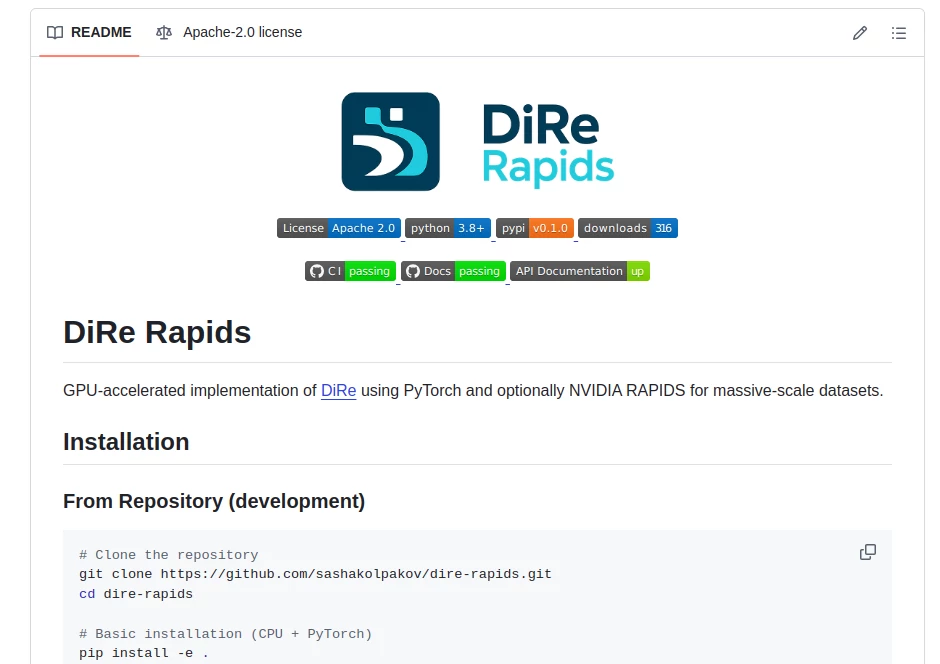DiRe-RAPIDS
Verified Blue CheckMark
Verified Blue CheckMark products are featured above free or unverified listings.
This badge indicates authenticity and builds trust, giving your product higher visibility across the platform.
Upgrade to get verified
Verified Blue CheckMark products are featured above free or unverified listings. This badge indicates authenticity and builds trust, giving your product higher visibility across the platform.
Upgrade to get verified
Fast Dimensionality Reduction on the GPU

What is DiRe-RAPIDS?
Dire Rapids brings high-speed crunching to data visualization tasks, letting researchers handle hefty sets without the usual wait. This open-source gem speeds up embedding processes on graphics cards, making complex patterns pop out quicker for those knee-deep in analysis. Devs and scientists who've tried it often point to the way it turns hours of compute into minutes, opening doors to bigger explorations without breaking a sweat.
Introduction
Dire Rapids sprang from the need to push dimensionality tools beyond slow CPU limits, building on earlier work to harness GPU muscle for real-world crunching. A solo dev kicked it off a while back, pulling in folks wrestling with massive datasets in machine learning circles. It caught eyes fast among those tweaking neural nets or sifting through sensor floods, thanks to its knack for blending familiar methods with fresh acceleration tricks. Over time, tweaks from testers have honed it into a reliable pick for labs and startups alike, where spotting clusters in sprawling data isn't just nice—it's the edge that counts.
Key Features
User Interface
There's no flashy dashboard here; it's all about slipping into your code like an old pal, with simple imports and one-liner setups that fit right into notebooks. Examples in the docs walk you through tweaks via parameters, and verbose flags light up progress on screen without extra hassle. Coders appreciate how it slots into existing scripts, swapping out old reducers with a quick line change, keeping the focus on results over setup fiddles.
Accuracy & Performance
It holds true to the math roots, delivering embeddings that match hand-tuned runs while slashing times—think datasets that once crawled now flying through in chunks. On beefy cards, memory tweaks like half-precision cut usage in half, and sampling keeps things zippy even past fifty thousand points. Folks testing it on real floods report steady outputs that scale without drifting, proving the speed doesn't skim on the details.
Capabilities
You can dial in neighbor counts or embed sizes on the fly, layering in custom math for distances like straight-line or angle-based to suit your data's quirks. Backends flip automatically if you've got the right gear, from basic torch runs to full RAPIDS blasts for the giants. It juggles chunks smartly for big loads, and options like lazy tensors keep repulsion calcs lean, letting you probe everything from toy blobs to production streams.
Security & Privacy
As a local-run library, it keeps your data on your machine, no cloud handoffs or sneaky logs to worry over. Dependencies stick to vetted packs, and editable installs mean you peek under the hood anytime. Open code invites community eyes on weak spots, so risks stay low for those crunching sensitive sets without extra shields.
Use Cases
Data wranglers in bio labs embed gene profiles to hunt patterns in thousands of samples, spotting links that fuel breakthroughs. ML tinkerers visualize feature spaces for better model tweaks, iterating faster on clusters that guide training splits. Sensor teams sift IoT streams for anomalies, turning raw feeds into actionable maps without gridlock. Even educators drop it into classes, showing kids how high-dim chaos unfolds into clear views with a few lines.
Pros and Cons
Pros:
- Blasts through big data on GPUs, freeing up hours for deeper digs.
- Picks the right engine automatically, no hardware guesswork.
- Custom distance options bend to odd data shapes effortlessly.
- Light footprint with smart memory tricks for lean runs.
Cons:
- Needs CUDA setup for the full kick, a hurdle for CPU-only rigs.
- RAPIDS add-on means extra installs for the biggest hauls.
- Learning curve on backend flags for peak tweaks.
Pricing Plans
It's all free as open-source fare, grabbing the full kit from PyPI or the repo without a cent. Folks can fork and fiddle at will, and while no paid tiers exist, community pulls keep it fresh. Optional extras like RAPIDS come with their own zero-cost tags, making it a no-brainer for budget-tight teams chasing high-end crunch.
How to Use Dire Rapids
Start by cloning the spot or pip-ing the pack, then fire up a notebook with your data load. Import the reducer class, set your dims and neighbors, and call fit on your array—watch verbose spits track the grind. Swap metrics with a string or function for custom flavors, and embed away. For giants, flip to the lean backend and tweak sampling to keep memory in check, saving outputs for plots or downstream digs.
Comparison with Similar Tools
Next to JAX flavors, it trades some flex for torch's broad reach and RAPIDS' raw power, though JAX might edge in pure speed on certain cards. Against CPU standbys like sklearn, the GPU leap shines on scales, but those win for quick prototypes without gear. It carves a niche for torch fans needing massive embeds where others lag or lock you in.
Conclusion
Dire Rapids clears the path for bold data dives, wrapping heavy math in GPU grease that lets insights flow free. It empowers tinkerers to chase patterns in floods that once daunted, turning raw heaps into stories worth telling. As datasets keep swelling, this tool rides the wave, proving fast views aren't luxuries—they're the new baseline for smart exploration.
Frequently Asked Questions (FAQ)
Do I need a GPU to run it?
It works on CPUs too, but shines brightest with CUDA-ready cards for the speed boost.
How big can datasets get?
Handles millions with RAPIDS, though lean modes cap comfy at hundreds of thousands.
Can I use my own distance math?
Yep, plug in functions for anything from Manhattan to your wild custom brew.
What's the go-to for memory hogs?
Lean backend with FP16 and sampling keeps things tidy without skimping on quality.
How do I tweak for my setup?
The auto-create picks smart, or pick classes directly for full reins.
AI Data Mining , AI Developer Tools , AI Research Tool , Other , Github Repos .
These classifications represent its core capabilities and areas of application. For related tools, explore the linked categories above.
DiRe-RAPIDS details
Pricing
- Free
Apps
- Web Tools
















